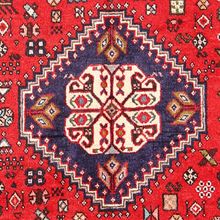Abadeh Rug
| Abadeh Rug | |
|---|---|
 Design of Abadeh Rug (Rugman) | |
| General information | |
| Name | Abadeh Rug |
| Original name | قالی آباده |
| Alternative name(s) | Abadeh Carpet |
| Origin | |
| Category | Village |
| Technical information | |
| Common designs | Tribal, Geometric, Vase |
| Common colors | Red, Ivory, Beige, Blue, Yellow |
| Dyeing method | Natural, Synthetic |
| Pile material | Wool |
| Foundation material | Cotton, Goat Hair |
| Knot type | Symmetrical (Turkish), Asymmetrical (Persian) |
Abadeh Rug originate from the town of Abadeh. Located in the tribal and nomadic region of Iran between Isfahan and Shiraz, it is well known for marquetry, making light cotton summer shoes called givehs, and for magnificent hand-woven wool rugs. Women of Qashqai origin ply their centuries old craft primarily using flat woven style knots, creating exquisite rugs that are very firm and closely knotted. The Qashqai are a tribal federation of different ethnic backgrounds including Arabs, Kurds, Lurs, and Turks. The influence of Turkoman and Caucasian styles is evident in their designs. Abadeh rugs are woven in the village on smaller looms usually kept in the living room or main bedroom and can take from months up to one or two years to complete, depending on the size.
History
Abadeh is a town located on the main road between Isfahan and Shiraz in the Fars Province of southwestern Iran. Abadeh rugs are known in the market from the mid-twentieth century. The rugs have a cotton foundation and a wool pile. The Persian (asymmetric) knot is used.
The designs are geometric and have Shiraz regional tribal styles. The patterns are allover, single medallion, or multiple medallions in the center of the field. Generally, the medallions are lozenge-shaped and surrounded by stylized Hook motifs. Small flower heads, leaves, vines, animals, and birds are applied in the field designs. Early Abadeh rugs, especially those of high quality, have the mil Sultan pattern of vase with flower bouquets and birds on both sides repeated in the field on an ivory background.
The background colors of Abadeh rugs are mainly reds, but gold, blues, turquoise, camel, and ivory also appear. The borders, in general, have reds or dark blues. In addition to these colors, shades of green, brown, cinnamon, and gray were used for the flowers and design elements. Dark brown or black was used for design outlines.
Abadeh rug grade quality is medium to fine, with excellent tribal pile wool. The rugs were made with a double weft and are durable. The dimensions range from mats to small room-size rugs. Large quantities of square-format rugs, suitable for the European market, were produced. Abadeh rugs were exported in high volume because of their durability and nomadic designs.
By the late twentieth century, some weavers from Abadeh converted from their original designs to make carpets and rugs in the styles of other weaving regions in Iran to meet the demand of domestic and export consumers.[1]
See also
| Search for Abadeh Rug on Wikipedia. |
References
- ↑ Moheban, 2015, 33
Bibliography
- Abraham Levi Moheban. 2015. The Encyclopedia of Antique Carpets: Twenty-Five Centuries of Weaving. NewYork: Princeton Architectural Press.